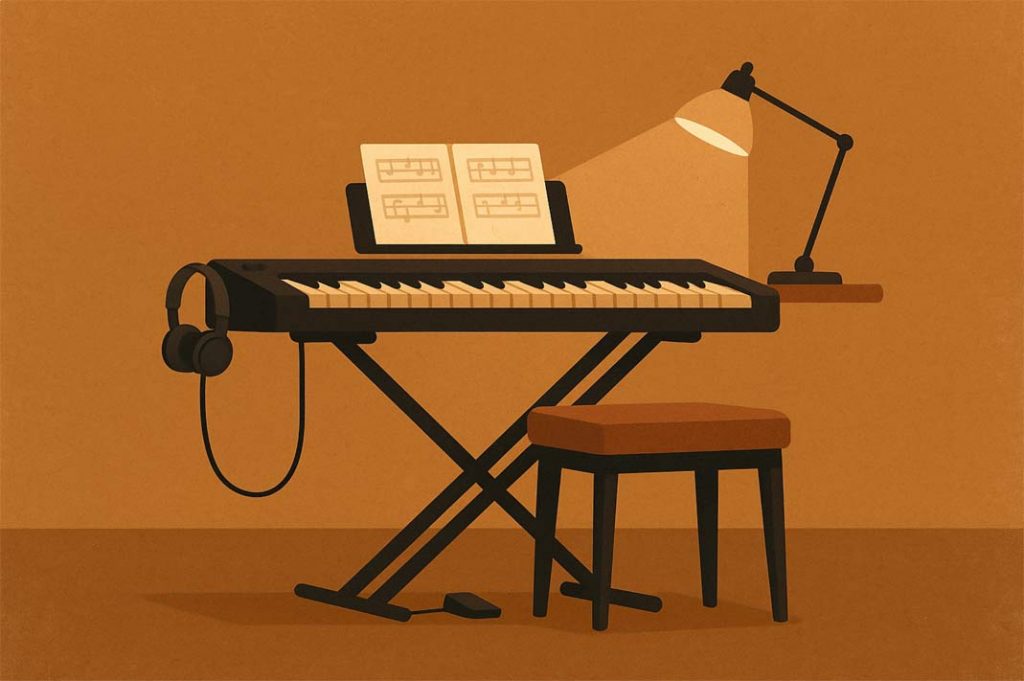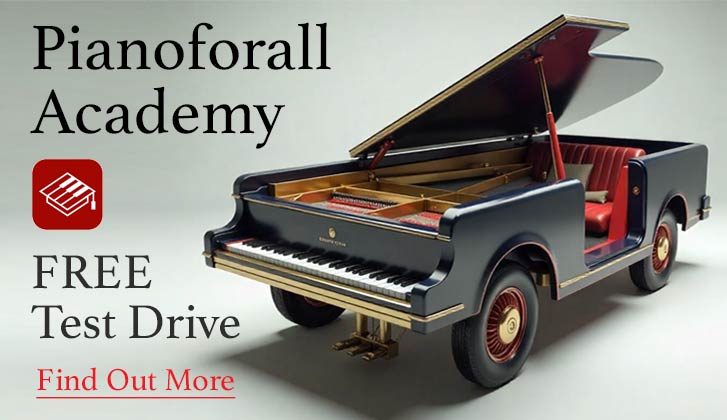The Short Answer: Minimum Spec Checklist
- Keys: At least 61 full-size keys (88 is best; 76 is a solid compromise).
- Touch Sensitivity: Non‑negotiable. If it doesn’t respond to how hard you play, walk away.
- Action: Weighted or semi‑weighted feels most piano‑like and encourages better technique.
- Sustain Pedal: Must have a pedal input and a compatible, piano‑style pedal.
- Stand & Seat: Stable, height‑adjustable stand and a comfortable, height‑adjustable stool.
- Connectivity: Headphone jack, and ideally USB‑MIDI for learning apps/DAWs.
- Built‑ins: Decent speakers; optional rhythm/backing tracks that make practice fun.
Not sure which route suits your keyboard? Before you choose, compare top piano apps in this honest guide.
How to Pick the Right Keyboard
Number of Keys
Is 61 enough? It’s acceptable if money or space is tight, but you’ll quickly miss the low notes. 76 is better. 88 is best and future‑proof.
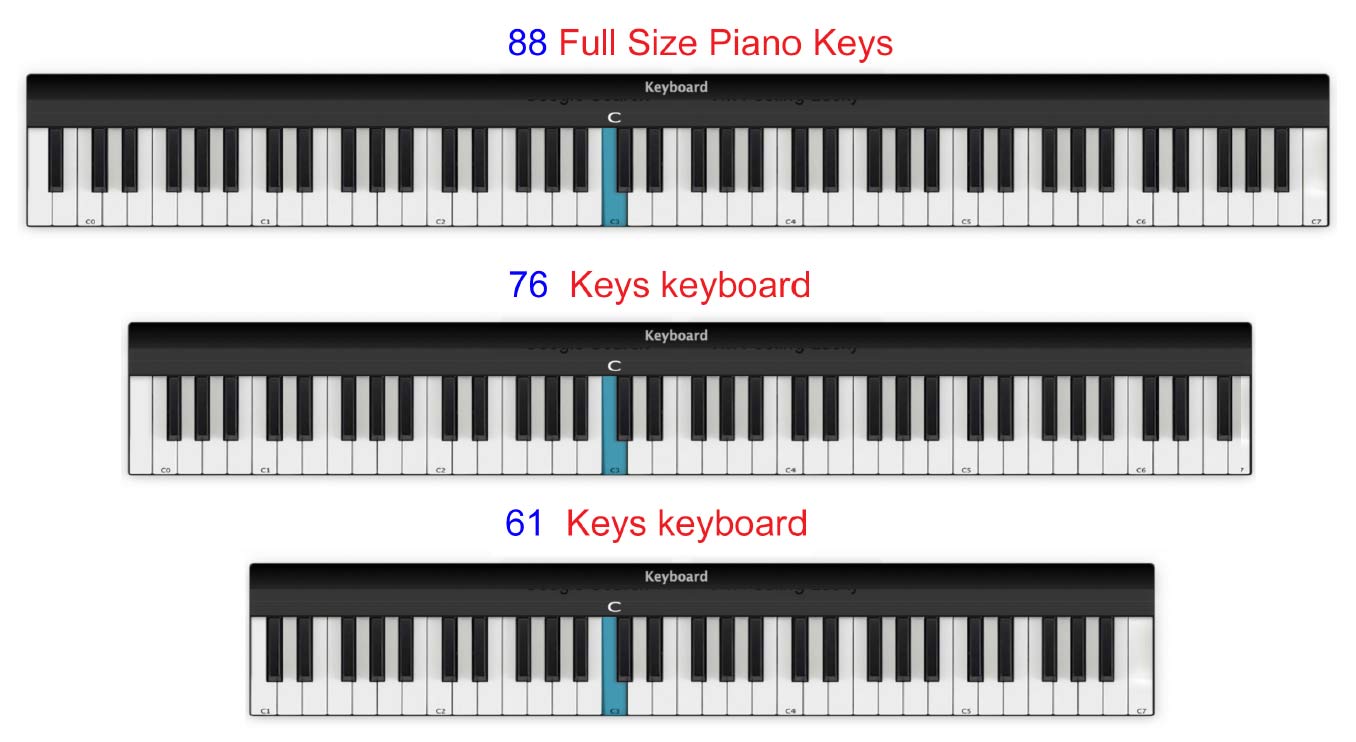
Touch Sensitivity
This is crucial. With touch sensitivity, notes sound louder when you play harder and softer when you play lightly. Without it, every note is the same volume—robotic and joyless.
Key Action (Feel)
Weighted or semi‑weighted keys feel more like a piano and help you develop control. Ultra‑light “synthy” keys can work, but they often feel toy‑like to beginners.
Sounds, Styles & Backing Tracks
You don’t need 1,000 sounds. One great piano voice beats a pile of mediocre ones. That said, backing tracks can be a game‑changer: they tighten your timing and make practice addictive. On some models it’s easier to access rhythms and get sensible sustain behaviour in split mode than on others—try before you buy.
Speakers, Headphones & Connections
Built‑in speakers are handy. Headphones keep the peace. USB‑MIDI lets you connect to learning apps and recording software. And please check the rear panel for a sustain pedal input.
Brand Sanity Check
Stick with reputable makers and, if possible, test in person. Bring headphones if you’re shy—no one in a music shop will mind.
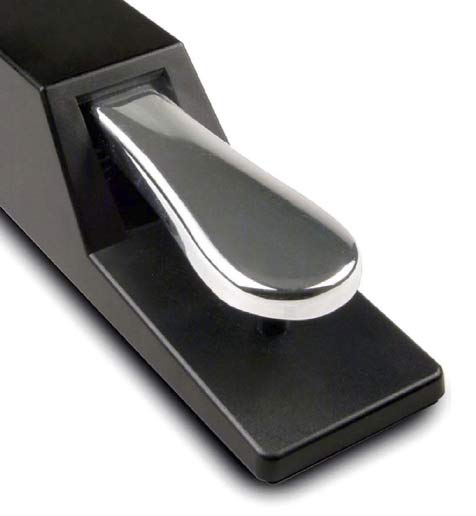
The Sustain Pedal: Non‑Negotiable
What It Does
A sustain pedal lets notes continue after you lift your fingers. Without it, everything sounds clipped and staccato.
Choose the Right Pedal
- Get a piano‑style pedal, not the tiny plastic square that skates around the floor.
- Make sure it’s compatible with your keyboard (polarity matters).
- Pro tip: Don’t rest your foot on the pedal when you power on; if you do, sustain may work in reverse. Power off, foot off, power on again to fix.
Why the “Sustain” Button Isn’t Enough
Keyboard sustain settings usually apply continuous sustain, which turns your playing into a blurry soup. A real pedal gives you on‑demand sustain and clarity.
Keyboard Stand
Use a stable, height‑adjustable stand. Wobbly stands waste technique and patience.
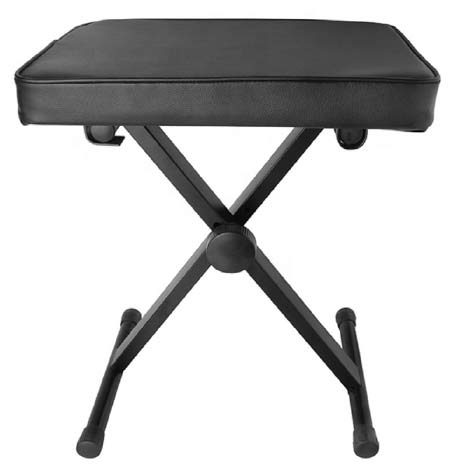 Bench/Stool
Bench/Stool
Comfort matters. Choose a thickly padded, height‑adjustable seat so you can practice longer without aches.
Height & Posture
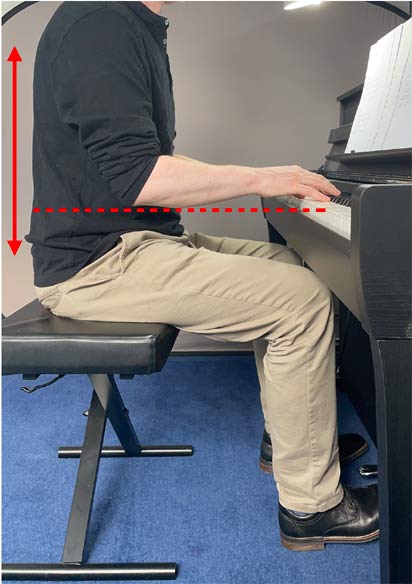
On an acoustic piano, the key tops sit roughly 71–74 cm (28–29 inches) from the floor. Aim for that, then adjust your stool so your forearms are parallel to the ground (or very slightly above the keys). Sit close enough to stay upright without reaching; feet flat, shoes flexible for pedalling.
Hand Position & Smart Seat Adjustments
Keep your palms roughly parallel to the floor; avoid collapsed or overly bent wrists. If a piece lives mostly left of middle C, slide yourself a touch left so the whole thing feels centred and relaxed.

Lighting & Environment
Good light reduces eye strain—useful if you’re reading printed pages on the stand. Keep the area uncluttered so nothing fights your hands or your focus.
Stay Relaxed
New muscles, new habits—some tension is normal at first. Take short breaks, roll the shoulders, shake out the arms. Every so often, soften the belly and let the breath resume its natural rhythm.
Quick Setup Checklist
- Keyboard with touch sensitivity, 76–88 keys preferred, weighted/semi‑weighted action.
- Piano‑style sustain pedal, polarity matched; pedal input verified.
- Stable adjustable stand; padded adjustable stool.
- Headphones; optional USB‑MIDI cable.
- Seat height set for forearms parallel to the keys; feet flat.
- Decent lighting; clutter‑free space.
Buying Tiers (Specs, Not Brands)
- Good: 61 keys, touch sensitive, semi‑weighted, pedal input, headphones.
- Better: 76 keys, semi‑weighted, stronger speakers, rhythm/backing features, USB‑MIDI.
- Best: 88 keys, weighted action, realistic piano sound, robust speakers, full connectivity.
Getting started? Read the beginner guide or start a free lesson.
Ready to choose? Choosing a Keyboard or Digital Piano (Beginner’s Guide)

